Unit 6 Eat Well 第3课时(Section A Grammar Focus 3a-3d)语法课课件+内嵌音视频(2024鲁教版英语六年级下)
文档属性
| 名称 | Unit 6 Eat Well 第3课时(Section A Grammar Focus 3a-3d)语法课课件+内嵌音视频(2024鲁教版英语六年级下) | 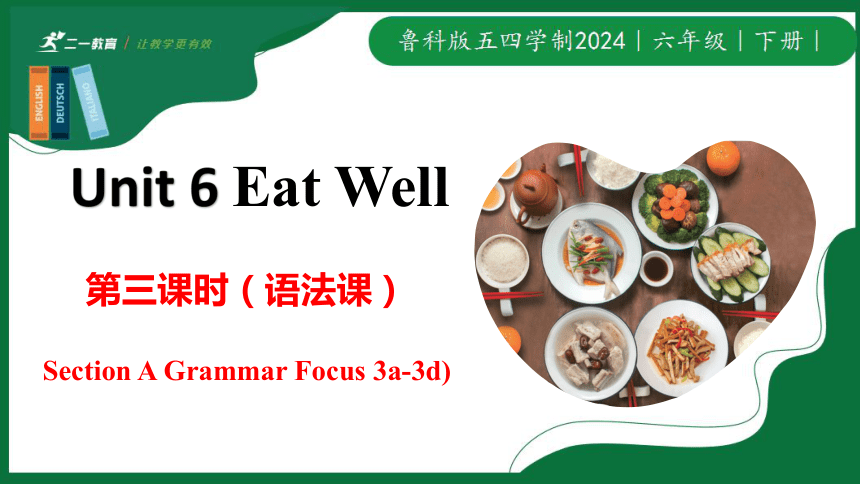 | |
| 格式 | pptx | ||
| 文件大小 | 30.3MB | ||
| 资源类型 | 试卷 | ||
| 版本资源 | 鲁教版 | ||
| 科目 | 英语 | ||
| 更新时间 | 2025-05-07 16:34:37 | ||
图片预览

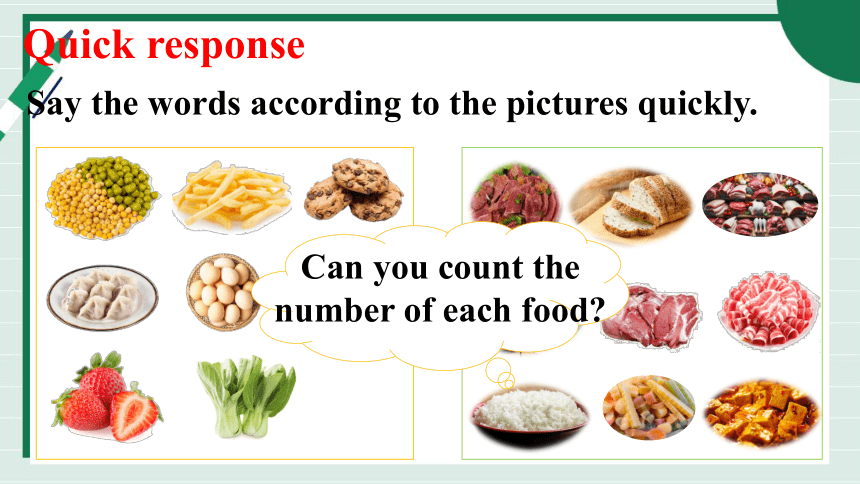
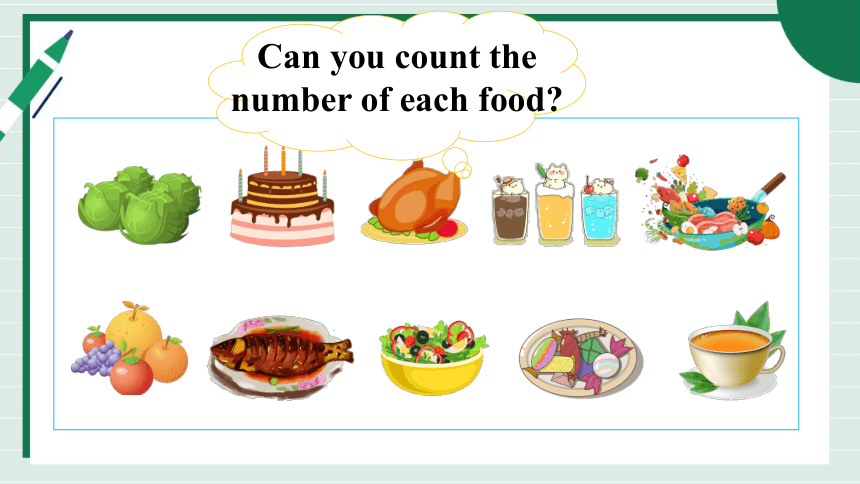
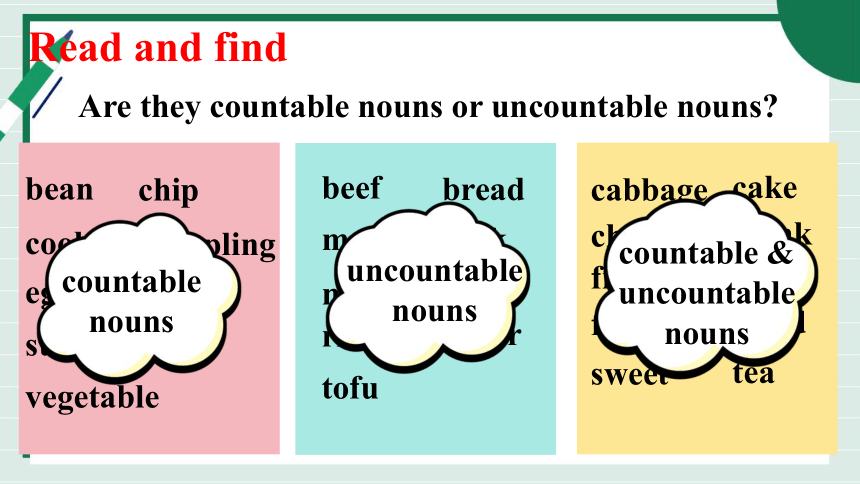
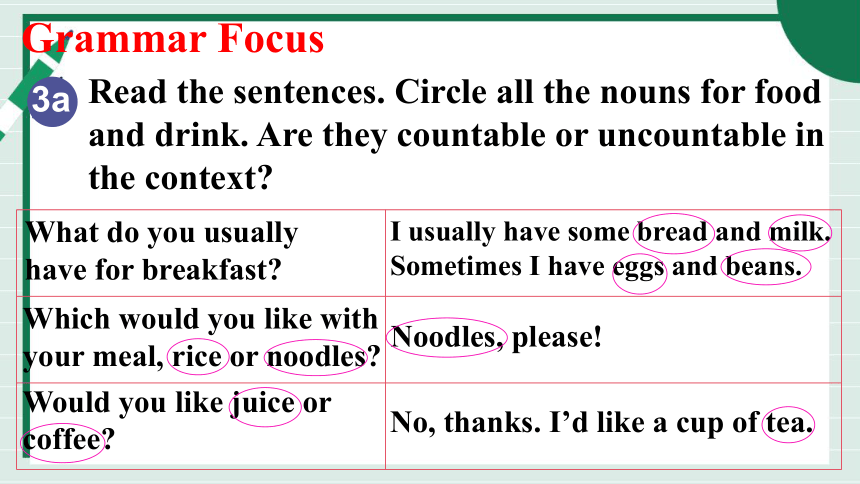
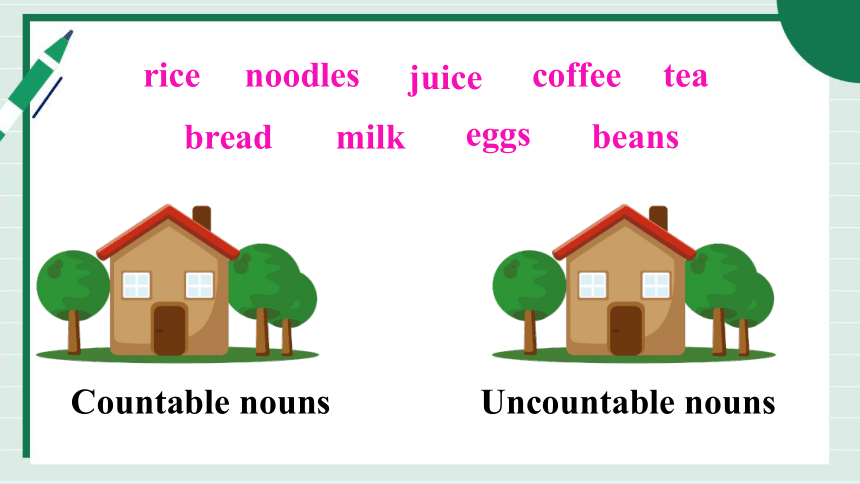
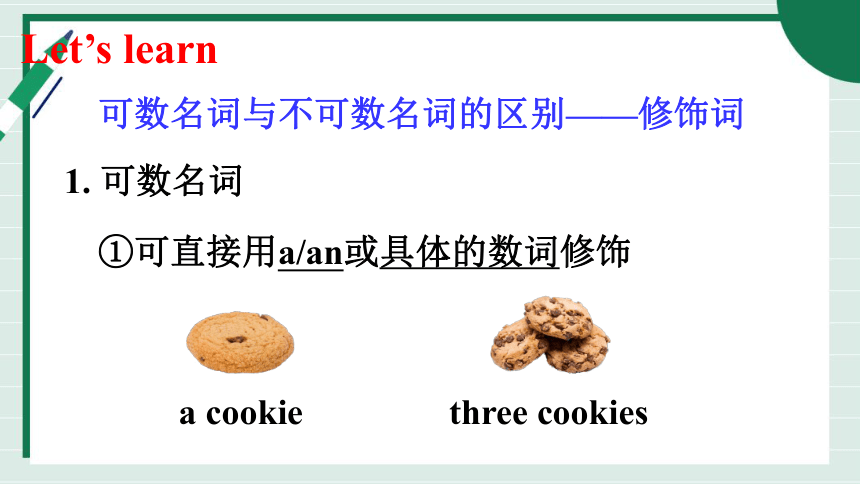
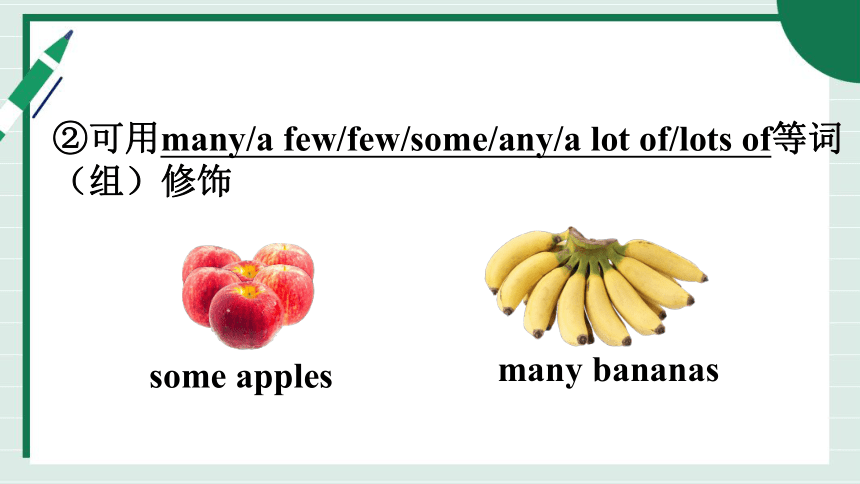
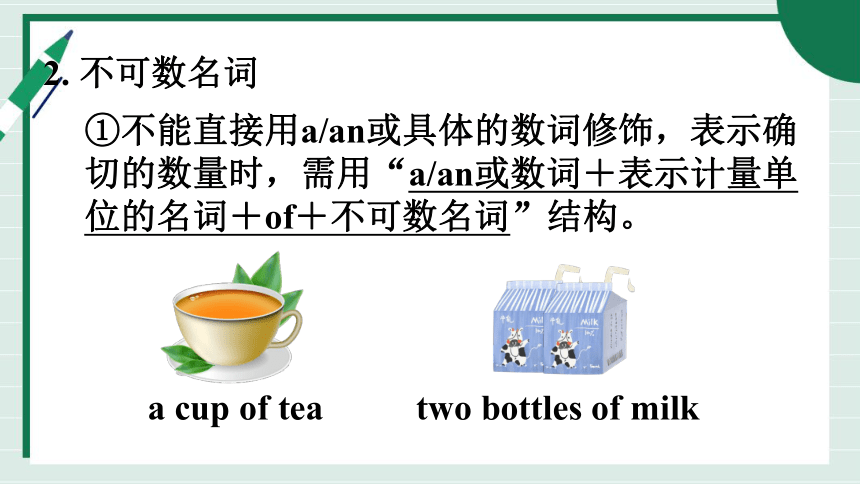
文档简介
(共28张PPT)
Unit 6 Eat Well
第三课时(语法课)
Section A Grammar Focus 3a-3d)
Quick response
Say the words according to the pictures quickly.
Can you count the number of each food
Can you count the number of each food
Read and find
bean
beef
chip
cookie
dumpling
egg
noodle
strawberry
vegetable
cabbage
bread
meat
milk
mutton
pork
rice
sugar
tofu
sweet
cake
chicken
drink
fish
food
fruit
salad
tea
Are they countable nouns or uncountable nouns
countable nouns
uncountable nouns
countable &
uncountable nouns
3a
Read the sentences. Circle all the nouns for food and drink. Are they countable or uncountable in the context
Grammar Focus
What do you usually have for breakfast
I usually have some bread and milk. Sometimes I have eggs and beans.
Which would you like with your meal, rice or noodles
Noodles, please!
Would you like juice or coffee
No, thanks. I’d like a cup of tea.
noodles
rice
juice
coffee
tea
bread
milk
eggs
beans
Countable nouns
Uncountable nouns
1. 可数名词
①可直接用a/an或具体的数词修饰
可数名词与不可数名词的区别——修饰词
a cookie
three cookies
Let’s learn
②可用many/a few/few/some/any/a lot of/lots of等词(组)修饰
some apples
many bananas
2. 不可数名词
①不能直接用a/an或具体的数词修饰,表示确
切的数量时,需用“a/an或数词+表示计量单位的名词+of+不可数名词”结构。
a cup of tea
two bottles of milk
②可用much/a little/little/some/any/a lot of/lots of等词(组)修饰。
some juice
可数名词与不可数名词的区别——谓语动词
1. 可数名词
①可数名词单数作主语时,谓语动词用第三人称单数形式。
An apple a day ______(keep) the doctor away.
keeps
②可数名词复数或多个可数名词单数作主语时,
谓语动词用复数形式。
There ______(be) ten oranges on the table.
are
2. 不可数名词
①不可数名词作主语时,谓语动词用第三人称单数形式。
The beef soup ______(taste) delicious.
tastes
②当不可数名词前表示计量单位的名词是复数时,谓语动词用复数形式。
Two boxes of milk ___(be) only 6 yuan in our shop.
are
可数名词与不可数名词的区别——提问(数)量
对可数名词的数量提问用how many,对不可数名词的量提问用how much。
How _____(many/much) eggs are there on the table
many
How _____(many/much) milk is there in the bottle
much
注意:有些名词既可以作可数名词,又可以作不可数名词。如:
chicken
fish
(可数名词)鸡
(不可数名词)鸡肉
(可数名词)
鱼的数量或种类
(不可数名词)鱼肉
3b
Complete the jokes with the correct forms of the nouns in brackets.
1. Customer: Do you serve ______ (fish)
Waitress: Sir, we serve everyone.
fish
customer n. 顾客
waitress n. 女服务员
serve n. 提供;服务
sir n. 先生
What does “serve” in customer’s words mean
A. 提供 B. 服务
1. Customer: Do you serve _____ (fish)
Waitress: Sir, we serve everyone.
fish
What does “serve” in waitress’s words mean
A. 提供 B. 服务
2. Waiter: Would you like the ____ (bill) now
Customer: You can bring it over, but I’m sure I
won’t like it!
bill
What does the word “bill” mean there
A. 纸币 B. 账单
3. Waitress: Would you like ______ (chip),
_______ (noodle), or ____ (rice) to
go with your ________ (chicken)
Customer: I don’t know. Where is my chicken going
chips
noodles
rice
chicken
搭配;相配
What does “chicken” in customer’s words mean
A. 鸡 B. 鸡肉
What does “chicken” in waitress’s words mean
A. 鸡 B. 鸡肉
I try to eat healthy food every day. I eat fruit and __________ (vegetable) with every meal. I don’t eat ______ (sweet). Instead, I have a pear, a banana, or some ____________ (strawberry)! I love juice, but my mum says that it’s not good to drink too much of it. It usually has a lot of _____ (sugar). Now I try to drink more ______ (water) and _____ (milk).
Scan and find
What’s the main idea of the passage Underline the key sentence.
How does the writer try to eat healthy food every day
3c
Complete the passage with the correct forms of the nouns in brackets.
I try to eat healthy food every day. I eat fruit and __________(vegetable) with every meal. I don’t eat ______(sweet). Instead, I have a pear, a banana, or some ____________(strawberry)! I
vegetables
sweets
strawberries
n. 梨
adv. 反而;代替
love juice, but my mum says that it’s not good to drink too much of it. It usually has a lot of _____
(sugar). Now I try to drink more ______(water) and _____(milk).
sugar
water
milk
too much 太多
sugar n. 糖
Read and answer
How does the writer try to eat healthy food every day
eats fruit and vegetables with every meal
doesn’t eat sweets → has a pear, a banana, or some strawberry
loves juice → not good to drink too much
tries to drink more water and milk
Watch and think
How do we eat healthily
3d
Imagine that your friends are at your home. Offer them food and drink.
A: Would you like ... or ...
B: I’d like ...
A: What ... would you like, ... or ...
B: ..., please.
Your pen pal comes to visit you, you take him/her to the food street. Recommend him/her some delicious food and drink.
A: Would you like ... or ...
B: I’d like ...
A: What ... would you like, ... or ...
B: ..., please.
Summary
可数名词与不可数名词的区别
1. 修饰词
2. 谓语动词
3. 提问(数)量
1. Review the new words and phrases.
2. Review the knowledge about countable nouns and
uncountable nouns.
3. Make conversations about offering food and drinks.
Homework
Thanls for listening
Unit 6 Eat Well
第三课时(语法课)
Section A Grammar Focus 3a-3d)
Quick response
Say the words according to the pictures quickly.
Can you count the number of each food
Can you count the number of each food
Read and find
bean
beef
chip
cookie
dumpling
egg
noodle
strawberry
vegetable
cabbage
bread
meat
milk
mutton
pork
rice
sugar
tofu
sweet
cake
chicken
drink
fish
food
fruit
salad
tea
Are they countable nouns or uncountable nouns
countable nouns
uncountable nouns
countable &
uncountable nouns
3a
Read the sentences. Circle all the nouns for food and drink. Are they countable or uncountable in the context
Grammar Focus
What do you usually have for breakfast
I usually have some bread and milk. Sometimes I have eggs and beans.
Which would you like with your meal, rice or noodles
Noodles, please!
Would you like juice or coffee
No, thanks. I’d like a cup of tea.
noodles
rice
juice
coffee
tea
bread
milk
eggs
beans
Countable nouns
Uncountable nouns
1. 可数名词
①可直接用a/an或具体的数词修饰
可数名词与不可数名词的区别——修饰词
a cookie
three cookies
Let’s learn
②可用many/a few/few/some/any/a lot of/lots of等词(组)修饰
some apples
many bananas
2. 不可数名词
①不能直接用a/an或具体的数词修饰,表示确
切的数量时,需用“a/an或数词+表示计量单位的名词+of+不可数名词”结构。
a cup of tea
two bottles of milk
②可用much/a little/little/some/any/a lot of/lots of等词(组)修饰。
some juice
可数名词与不可数名词的区别——谓语动词
1. 可数名词
①可数名词单数作主语时,谓语动词用第三人称单数形式。
An apple a day ______(keep) the doctor away.
keeps
②可数名词复数或多个可数名词单数作主语时,
谓语动词用复数形式。
There ______(be) ten oranges on the table.
are
2. 不可数名词
①不可数名词作主语时,谓语动词用第三人称单数形式。
The beef soup ______(taste) delicious.
tastes
②当不可数名词前表示计量单位的名词是复数时,谓语动词用复数形式。
Two boxes of milk ___(be) only 6 yuan in our shop.
are
可数名词与不可数名词的区别——提问(数)量
对可数名词的数量提问用how many,对不可数名词的量提问用how much。
How _____(many/much) eggs are there on the table
many
How _____(many/much) milk is there in the bottle
much
注意:有些名词既可以作可数名词,又可以作不可数名词。如:
chicken
fish
(可数名词)鸡
(不可数名词)鸡肉
(可数名词)
鱼的数量或种类
(不可数名词)鱼肉
3b
Complete the jokes with the correct forms of the nouns in brackets.
1. Customer: Do you serve ______ (fish)
Waitress: Sir, we serve everyone.
fish
customer n. 顾客
waitress n. 女服务员
serve n. 提供;服务
sir n. 先生
What does “serve” in customer’s words mean
A. 提供 B. 服务
1. Customer: Do you serve _____ (fish)
Waitress: Sir, we serve everyone.
fish
What does “serve” in waitress’s words mean
A. 提供 B. 服务
2. Waiter: Would you like the ____ (bill) now
Customer: You can bring it over, but I’m sure I
won’t like it!
bill
What does the word “bill” mean there
A. 纸币 B. 账单
3. Waitress: Would you like ______ (chip),
_______ (noodle), or ____ (rice) to
go with your ________ (chicken)
Customer: I don’t know. Where is my chicken going
chips
noodles
rice
chicken
搭配;相配
What does “chicken” in customer’s words mean
A. 鸡 B. 鸡肉
What does “chicken” in waitress’s words mean
A. 鸡 B. 鸡肉
I try to eat healthy food every day. I eat fruit and __________ (vegetable) with every meal. I don’t eat ______ (sweet). Instead, I have a pear, a banana, or some ____________ (strawberry)! I love juice, but my mum says that it’s not good to drink too much of it. It usually has a lot of _____ (sugar). Now I try to drink more ______ (water) and _____ (milk).
Scan and find
What’s the main idea of the passage Underline the key sentence.
How does the writer try to eat healthy food every day
3c
Complete the passage with the correct forms of the nouns in brackets.
I try to eat healthy food every day. I eat fruit and __________(vegetable) with every meal. I don’t eat ______(sweet). Instead, I have a pear, a banana, or some ____________(strawberry)! I
vegetables
sweets
strawberries
n. 梨
adv. 反而;代替
love juice, but my mum says that it’s not good to drink too much of it. It usually has a lot of _____
(sugar). Now I try to drink more ______(water) and _____(milk).
sugar
water
milk
too much 太多
sugar n. 糖
Read and answer
How does the writer try to eat healthy food every day
eats fruit and vegetables with every meal
doesn’t eat sweets → has a pear, a banana, or some strawberry
loves juice → not good to drink too much
tries to drink more water and milk
Watch and think
How do we eat healthily
3d
Imagine that your friends are at your home. Offer them food and drink.
A: Would you like ... or ...
B: I’d like ...
A: What ... would you like, ... or ...
B: ..., please.
Your pen pal comes to visit you, you take him/her to the food street. Recommend him/her some delicious food and drink.
A: Would you like ... or ...
B: I’d like ...
A: What ... would you like, ... or ...
B: ..., please.
Summary
可数名词与不可数名词的区别
1. 修饰词
2. 谓语动词
3. 提问(数)量
1. Review the new words and phrases.
2. Review the knowledge about countable nouns and
uncountable nouns.
3. Make conversations about offering food and drinks.
Homework
Thanls for listening
同课章节目录
